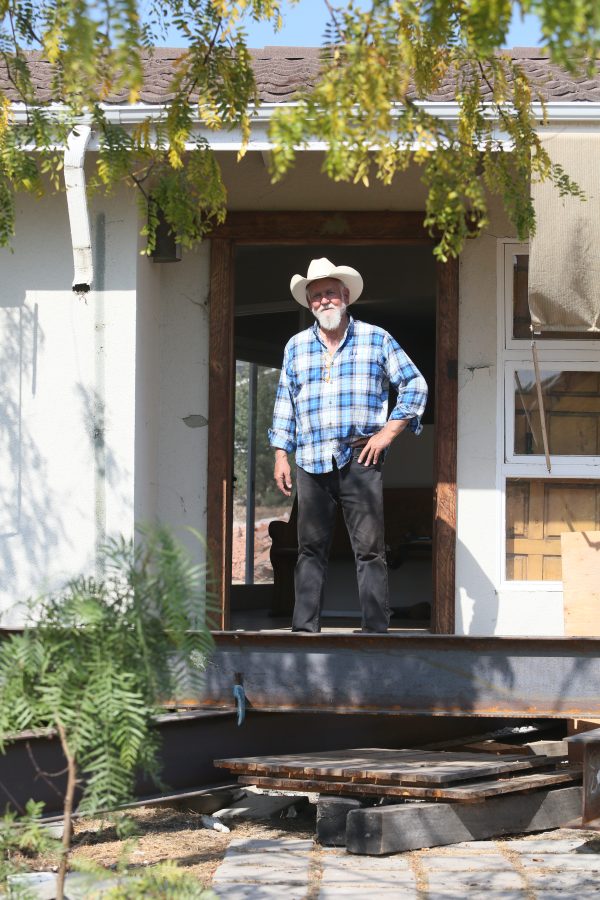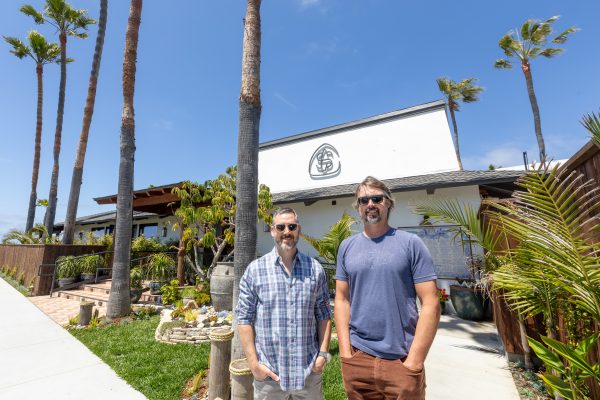“It reminds me of the Wild West. People are just saying screw it, I’m going to do what I need to do.” — Geologist Mike Phipps
by Chelsea Sektnan
When Southern California Edison cut power to 140 Portuguese Bend homes, and the sewage system on September 1, resident Guy Grant brought in three generators from his painting business to keep the sewage pumps running.
“They can’t mess with us—we’re going to get this done,” Grant told his grateful neighbors.
“It’s been really impressive to see all the neighbors pulling together,” lifetime Portuguese Bend resident Tony Baker said. “We live here because we love the area and, like a lot of people have said, where else would we go?”

SCE cut off the power to the area days after a line brought down by land movement sparked a fire. In recent months, the land has been moving up to one-foot per week.
City officials approved home construction in the Portuguese Bend, Altamura Canyon area, overlooking Abalone Cove in the 1950s, despite its history of landslides.
“My parents built here in 1948,” Baker said. “The county did not tell people this is an ancient landslide zone, but the geologists knew… the land had been moving for thousands of years.”
The area’s natural instability was worsened by grading and altered drainage that caused cracks in roads and shifting foundations. In 1956, a landslide triggered by construction on Crenshaw Boulevard, damaged over 100 homes. But development continued in the area now known as the Ancient Altamira Landslide Complex. In 1983, additional homes were built above the canyon with drainage systems that still direct water into Portuguese Bend.
“It was recognized as a landslide area in 1946, but it was thought to be stable, so development was allowed,” said Mike Phipps, a Principal Engineering Geologist at Cotton, Shires and Associates, a consultant for Rancho Palos Verdes. “When the city incorporated in 1973, it immediately implemented a moratorium, halting any further building in the landslide zone.”
“The two consecutive, very wet years, in 2022-23 and 2023-24, is what really set this landslide off. Water is the culprit. We have to do what we can to keep water from getting in and pull out what’s already in there,” Phipps said.
A recent breakthrough in the fight against the landslide has come with the installation of six dewatering wells on Abalone Cove Beach. The wells extract 650 gallons of water per hour—over one million gallons a day—from the neighborhoods overlooking the cove. This intervention has slowed the landslide’s movement from 13 inches per week to eight inches. But the land movement is still 80 times greater than it was in October 2022.
“We know slowing the movement is a direct result of the water extraction,” Phipps said. “The program has been successful, but it needs to be expanded.”
“Will things get back to normal? I don’t know what normal actually looks like,” Phipps said. “These properties have been dealing with creeping landslide movement for decades, but nothing of the magnitude that’s happening now. I don’t think it will get back to normal for quite a while. But if we can slow this landslide down, it will help preserve the homes.”
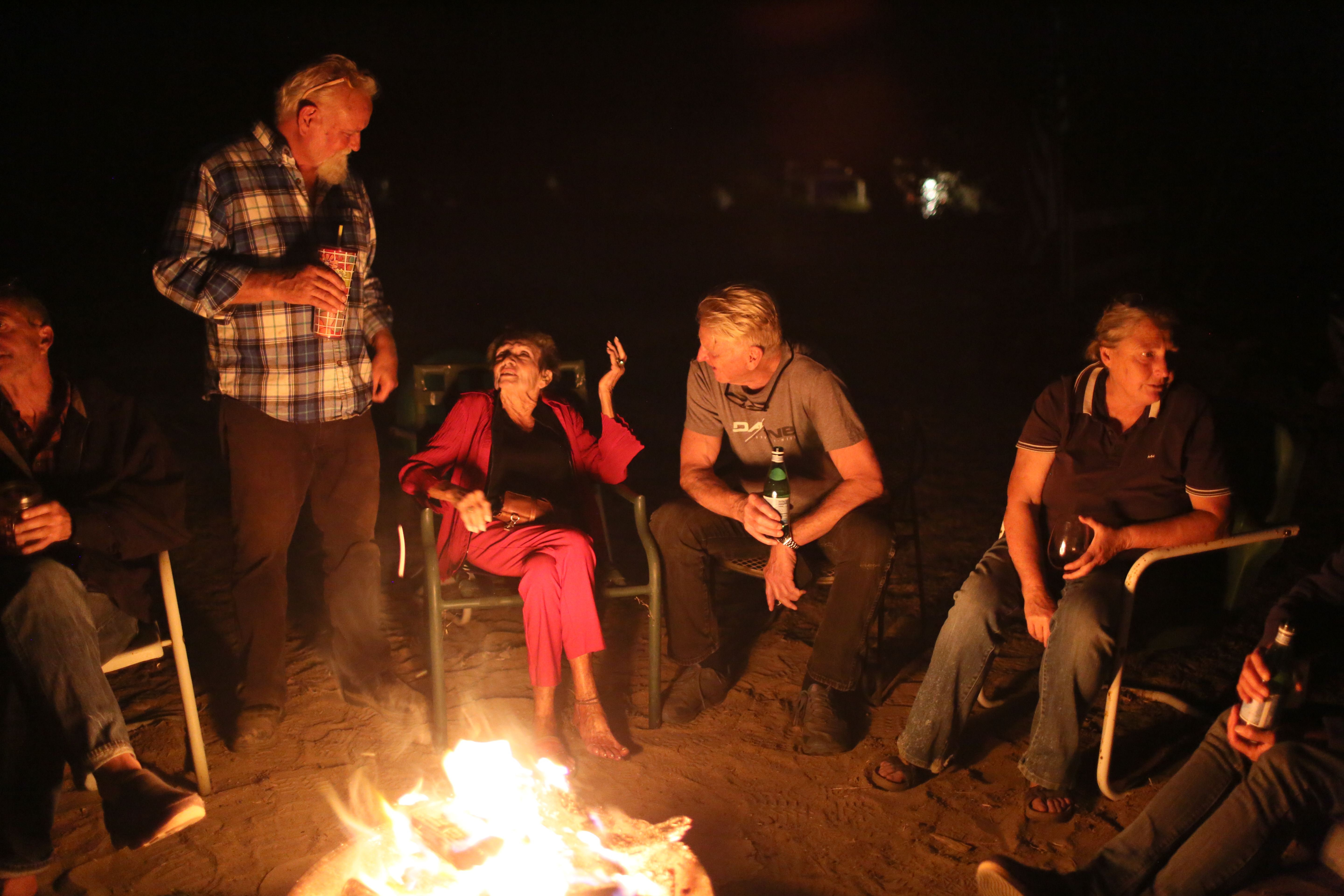
Portuguese Bend residents have drawn on the strength of their tight-knit bonds.
“We’re a bunch of rebels,” said Dave Zelhart, president of Terminal Equipment Services, and vice president of Pacific Crane Maintenance Company. He helped connect the generators to the sewer system. “This community is filled with either construction guys or artists. The artists will paint a crack with a daisy, and the construction guys will fix it.”
The foundation to Zelhart’s home is cracked in approximately 20 places.
“I put a giant girdle around my foundation to keep it together while waiting for the ground to dry out,” Zelhart said. Then, with help from his daughter and neighbors, Zelhart raised his house onto steel beams over just four weekends. His home now rides atop the shifting earth.
The formerly slow moving landslide is part of the Ancient Altamira Landslide Complex (a geological formation). It includes the Portuguese Bend Complex, Abalone Cove Complex, Klondike Canyon, and Beach Club landslides.
The landslide area is composed of unstable, sedimentary rock and water-absorbing clay that swells when it rains.
California Water Service has adapted to the shifting ground by moving water lines above ground and using flexible joints to prevent breaks. However, the ongoing movement remains a challenge.
“You would think the ground would move linearly—it does not,” Zelhart said. “It moves to the right, then to the left. We’re in this big swirling thing. You can’t be in it; you have to be on top of it.”
Sheri Hastings bought five acres in Portuguese Bend 1982. This year, the ground movement caused her horse barn to collapse.
“We noticed a tiny little crack in December,” Hastings said. “My husband started measuring it. It was a tenth of a millimeter one day, and by the end of February, it was in the inches—then feet —and pretty soon, the crack was as large as a patio. By April, it was 50 feet wide, and we had to bulldoze it.”
Hastings built a tack room from pieces of the barn. It sits just yards from a deep fissure where a 7-foot pole disappears before touching the bottom.
“This is an artists’ community,” Hastings said. “We’re not a bunch of rich people. We’re going to try to wait this out and see what we can do to repair the fissures. I want to stay here if I can. What I hope is that it stops—it’s always reached an equilibrium in the past.”
Hastings believes one answer to the problem is to resurrect the Altamira Canyon Creek Restoration Project. The project aimed to stabilize the area by reconfiguring the banks of the canyon, seal fissures and reroute storm drains.
“We want to do it in a way that it isn’t going to harm the environment but will also save our homes,” Hastings said. Residents are raising money for the project.
So far, just two homes have been red-tagged as uninhabitable by the city building department. Three homes have been yellow-tagged because of required repairs.
But natural gas, cable, internet, and electricity have been shut off indefinitely to nearly 400 homes, leaving families to rely on generators, solar power, and propane.
Cindy Keefer and her husband, Tom, have been without utilities for over a month.
“We have scrambled,” Keefer said, referring to the emotional and financial strain. The Keefers and their neighbors rely on propane and generators to maintain some sense of normalcy. “I try not to use the generator because it’s so polluting and noisy. I’m just thinking about what we can do to keep the neighborhood peaceful because everyone is so emotionally challenged.”
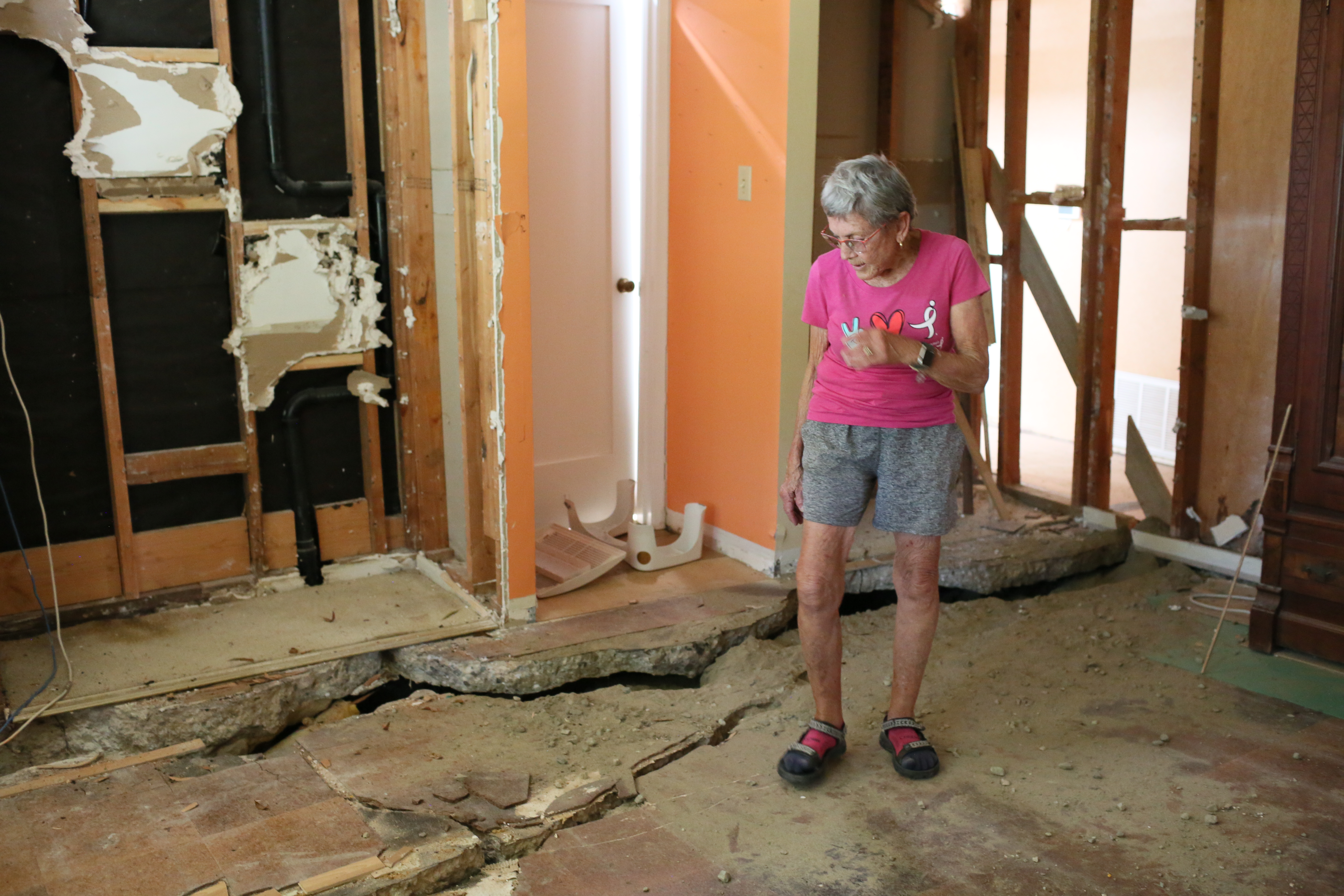
Sallie Reeves, 81, refuses to leave her home despite the danger of it being swallowed up.
“I’ve got the Grand Canyon in my master bedroom, but we’re going to get through this. The only way I’m leaving is in a box,” Reeves said.
Reeves’ family began packing up her home when the cracks grew wide enough for raccoons and rabbits to enter at night. Her home will soon be raised on steel beams. Reeves said the cost of repairs will take a huge chunk out of her retirement savings.
“We lived here for 42 years without a crack,” said the retired school psychologist. “And suddenly thresholds came apart, doors didn’t close. Little things started happening. The damage became more evident late in March when the crack opened up in my bedroom.”
Los Angeles County Supervisor Janice Hahn recently visited Reeves to examine the large fissure in her bedroom. Afterwards, Hahn announced a $5 million grant from the County to the City of Rancho Palos Verdes to address the worsening land movement.
The RPV City Council approved use of the $5 million grant to aid homeowners in the Portuguese Bend Community Association, including those on Vanderlip Drive, Seaview, and the Portuguese Bend Beach Club. Each of the 280 affected homeowners will receive $10,000.
The remaining funds will support the city’s ongoing stabilization efforts. The cost of the city’s emergency response could reach $55.3 million by June 2025, city officials estimate.
Governor Gavin Newsom has declared a state of emergency for the area. The declaration is helping cover city expenses related to the power shutoffs, but has yet to provide direct relief to homeowners.
“Our community has faced unfathomable challenges in the face of this landslide disaster, and it’s critical that we swiftly deploy this funding to support our residents who have been most impacted,” said Rancho Palos Verdes Mayor John Cruikshank in a press release.
“This is hopeful news,” said Gordon Leon, chair of the Abalone Cove Landslide Abatement District, California’s first geohazard abatement district.
“We’re hoping we can bring the landslide under control and have it move less than a couple of inches a year, not 9 to 11 inches a week.”
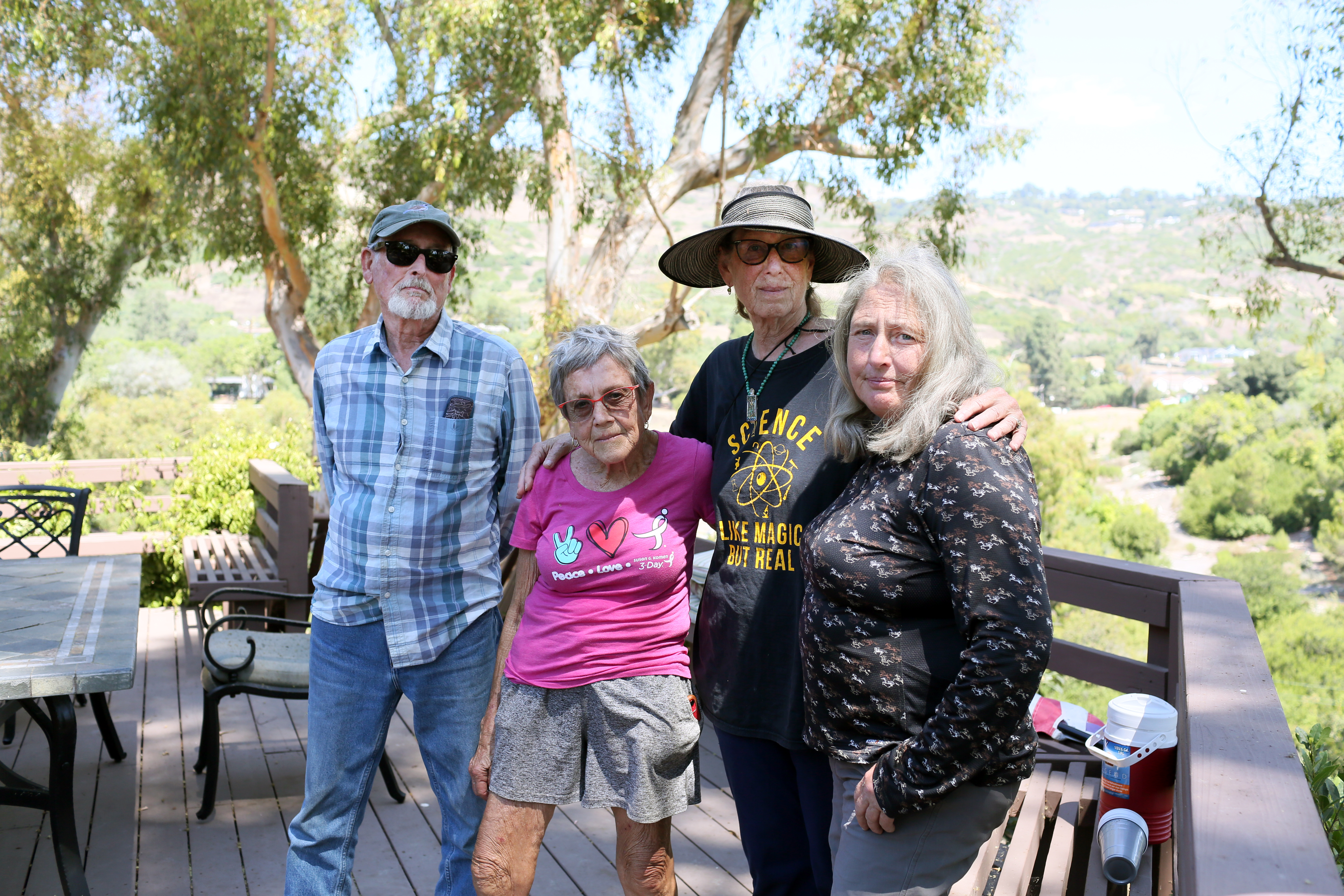
Portuguese Bend residents recently launched an art auction to raise money for the landslide mitigation efforts. The auction, organized by The Age of Art, features art donated from around the world. Proceeds will go toward emergency support for residents.
“This is all on our own. Anything that can mitigate the landslide, other than what Rancho Palos Verdes is doing at the toe [on the beach], is up to us,” Cindy Keefer said. “It has been very challenging to take it one step at a time and to keep up our good nature along this difficult journey.”
“These people up there are so resilient,” geologist Phipps said. “They’re taking matters into their own hands. It reminds me of the Wild West. People are just saying screw it, I’m going to do what I need to do.”
“Every time there’s a problem here, people figure out a solution,” Abalone Cove Landslide Abatement chair Leon said. “There’s a problem with gas—we went on propane. Problem with electricity? People got generators and slowly started switching to solar. They took away cable—we got Starlink.”
“We’ll soon be the most successful off-the-grid community in Los Angeles,” Cindy Keefer said. “By winter, you’re going to see solar powered Christmas lights.”
UPDATE
Buyouts offered RPV homeowners in landslide area
by Ralph Doyle
A $42 million voluntary buyout program for property owners in the Greater Portuguese Bend landslide area was announced on Monday, October 28, by the City of Rancho Palos Verdes. The funds will come from FEMA (the Federal Emergency Management Agency) and Cal OES (California Governor’s Office of Emergency Services).
The buyout is intended to help eligible homeowners relocate to safer areas by offering fair market value for their properties based on pre-disaster appraisals. Properties acquired by the City through this program will be deed-restricted for open space to prevent future development.
Ancient, slow-moving landslides in Rancho Palos Verdes have significantly accelerated since 2023, following two, consecutive, heavy rainy seasons. The movement has damaged homes, roads, and utilities, resulting in indefinite gas and electricity shut-offs for hundreds of homeowners.
“For the past two years, our residents have endured extraordinary hardships as a result of this landslide, with some facing the real prospect of losing their homes entirely,” Rancho Palos Verdes Mayor John Cruikshank said in a Monday, October 28 press release. “This buyout program provides a viable pathway forward for our most vulnerable community members, offering the opportunity to relocate and rebuild with meaningful compensation.”
Mayor Cruikshank announced the buy-outs at a special town hall meeting on Monday, October 28.
The $42 million is insufficient for buy-outs of the nearly 300 affected homes, which average well over $1 million. But Maor Cruikshank said, “Additional program cycles may become available in the future.”
Property owners interested in applying for the buyout program must request a property inspection from the City by Monday, November. 4 at 5:30 p.m.,and submit a completed program application by Friday, November. 8 at 4:30 p.m. Properties will be prioritized for selection based on safety concerns, structural condition, and utility statuses.
The City of Rancho Palos Verdes will purchase the properties for a price determined by an appraisal, based on the fair market value of the land on Dec. 1, 2022, prior to the acceleration of the landslide. The FEMA grant will pay for 75% of the sale, and property owners will contribute the remaining 25% through a reduction of the fair market value payment. For more information visit LandMovement@RPVca.gov or RPVca.gov/LandMovement.

